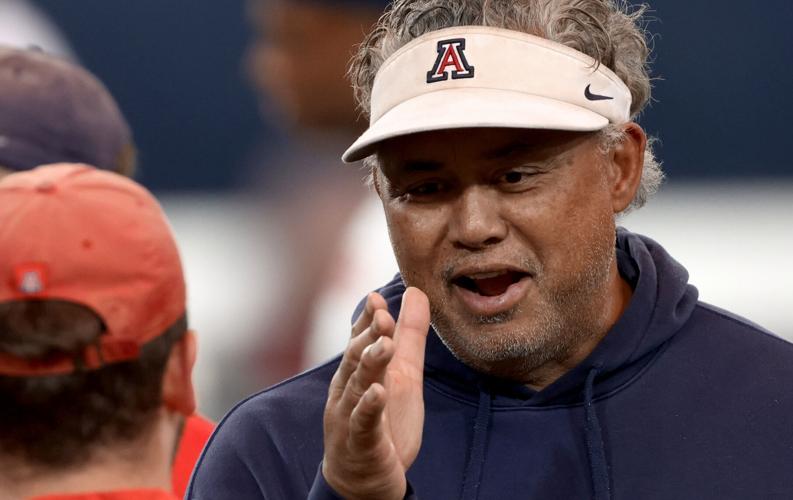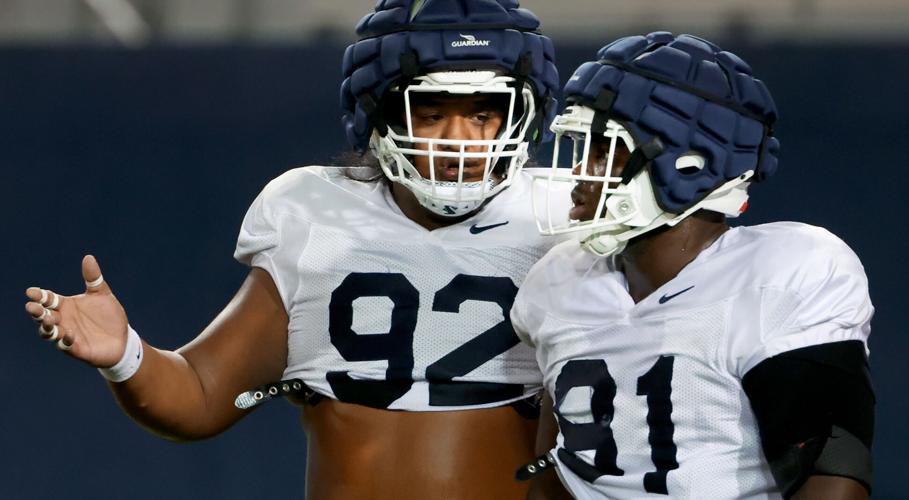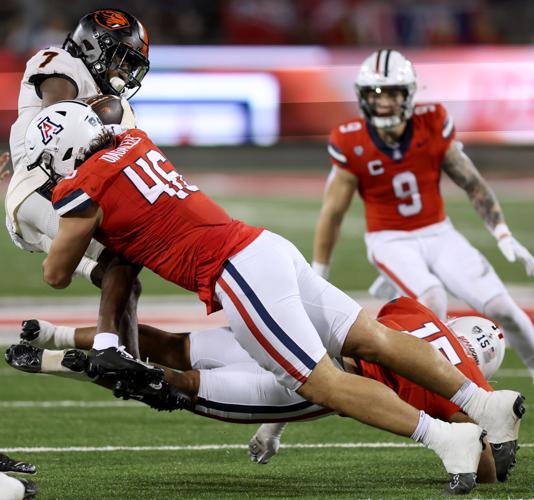One of the biggest reasons Arizona improved so much on defense last season: The Wildcats had a bunch of big bodies up front.
Five UA defensive tackles listed at 300-plus pounds played at least 226 snaps. Those behemoths enabled the likes of linebacker Jacob Manu to roam freely and pile up tackles.
Arizona climbed from 124th in the nation in run defense (209.1 yards per game) to 29th (118.2). UA opponents’ average per rush fell by nearly 2 yards (5.59 vs. 3.64).

Michael Lev is a senior writer/columnist for the Arizona Daily Star, Tucson.com and The Wildcaster.
It was a magnificent and meaningful transformation. With the start of the 2024 season just three weeks away, I worry about the Wildcats backsliding in that critical area.
What’s causing that concern? Arizona doesn’t have nearly as many big bodies up front as a year ago.
In 2023, the Wildcats had seven 300-plus-pound defenders who appeared in a game. Their top eight defensive tackles — including sub-300-pounder Ta’ita’i Uiagalelei, who often played inside — averaged 308.1 pounds.

Arizona defensive lineman Ta’ita’i Uiagalelei (46) takes Oregon State wide receiver Silas Bolden completely off his feet in the backfield on a busted play in the second quarter of the Wildcats’ Pac-12 victory over the Beavers on Oct. 28, 2023, at Arizona Stadium.
(As I don’t have the wherewithal to weigh every player, I’m using the numbers listed on the online roster. I cannot verify their veracity, but it’s the best we got.)
Five of the seven 300-pounders are no longer with the program because they graduated or transferred. Another, Keanu Mailoto, has dropped 20 pounds, from 300 to 280, per the online roster.
The 2024 Wildcats have two 300-pound defensive tackles: returnee Isaiah Johnson (311) and transfer Chubba Ma’ae (349). The average weight of their top nine interior defenders is 288.3 pounds — almost 20 less than last year.
The drop in size doesn’t guarantee a drop-off in play. UA coaches pushed back at the notion the Wildcats need more 300-pounders to be effective up front.
“I don’t care,” first-year defensive line coach Joe Seumalo said. “If they’re explosive, they’re quick, athletic, that’s what I want. If they’re 300 pounds ... they’re 300 pounds. But some of the best players that I’ve coached, I don’t think any of them were in the 300s.

Arizona defensive line coach Joe Seumalo talks to a another coach while the team gets loosened up for the Wildcats’ first night practice of the season Friday at Arizona Stadium.
“I value explosiveness. I value athleticism and passion. I’ve always kept that with me. That’s a Rich Ellerson thing. It’s been with me since then.”
Seumalo played under Ellerson in the late 1980s at Hawaii. Ellerson eventually followed Dick Tomey to Arizona, where, in the ’90s, the “Desert Swarm” defense was born.
Current UA defensive coordinator Duane Akina was part of that staff, and he alluded to the Desert Swarm days when sizing up the current D-line.
“I feel great about it,” Akina said. “We’ve changed our mentality up front. There’s a couple different ways, philosophies, on how to play with people. What we did a year ago is, we played more on the line of scrimmage — sit, big bodies, bang.
“I’m wired — where this program has been built, when I was first here in the ’80s — to get vertical. Never asked Rob Waldrop to sit on the line of scrimmage. Never asked (Tedy) Bruschi to sit on the line of scrimmage. We want to get vertical and across the line of scrimmage.”

Arizona defensive coordinator Duane Akina directs his players during a fall preseason practice at the Dick Tomey Practice Fields.
Waldrop and Bruschi — two locks for the UA Football Mount Rushmore — were undersized by modern standards. Waldrop is listed at 6-1, 276 pounds on his Pro Football Reference page. Bruschi (6-1, 247) was a linebacker masquerading as a defensive lineman.
Times have changed, though. Although the game is more spread out and less run-oriented, everyone is bigger. There are more 300-pound offensive linemen than ever before. The Wildcats struggled against the run for years because they didn’t have enough bulk to match up and hold up.
Seumalo and Akina revealed the change in defensive philosophy — getting vertical — back in spring. It’ll be interesting to see how it plays in the fall. The truth is, we might not really know until Week 3 when Arizona visits Kansas State. Think Utah, except in purple.

Arizona defensive linemen Chubba Ma’ae, left, and Isaiah Johnson head for their next station while running drills during the the Wildcats’ evening practice Friday at Arizona Stadium.
Based on what we’ve seen through eight training-camp practices, the linemen are taking to it. The two 300-pounders, Johnson and Ma’ae, have been regular visitors to the backfield.
Johnson is the early front-runner for most improved player on the team after playing just 11 snaps last season. Seumalo said Johnson is “like dynamite — explosive.”
Ma’ae, who arrived from UC Davis in January, has actually gotten lighter — and that’s a good thing. Ma’ae weighed about 380 pounds when he first got here. He’s now in the 345-350 range, he said. He has cut down on sugar and carbs, and it shows: Ma’ae looks like he belongs in FBS.
Even though they wouldn’t admit it, I’m sure Seumalo and Akina would like to have more players of Johnson and Ma’ae’s stature. That they don’t isn’t by design.
By the time they got here in late January, the transfer portal had been picked over. One of last year’s 300-pounders, Tiaoalii Savea, was on his way to Texas to continue playing for Johnny Nansen. Bill Norton followed in the spring. Jacob Kongaika was already gone, to ASU.

Syracuse defensive lineman Kevon Darton, right, pursues Florida State quarterback Jordan Travis during the first half of their game on Oct. 14, 2023, in Tallahassee, Florida. Darton is now at Arizona.
The UA staff did the best it could to fill those holes, which also included the departures of Tyler Manoa and Sio Nofoagatoto’a, both out of eligibility. Besides Ma’ae, Arizona brought in three defensive tackles: Kevon Darton, Jarra Anderson and Stanley Ta’ufo’ou. All are in the 275-280 range.
You know what position is the hardest to find and acquire in football? Large defensive tackles who can actually play. Seumalo said the Wildcats “hit a home run” with the portal pickups they made. Given the circumstances, I would agree.
Seumalo plans to attack the lack-of-size problem — if it is a problem — in a quantitative way. He’s aiming to have a D-line rotation — tackles and ends — consisting of 12 players.
That’s probably unrealistic. But I admire the ambition and thought process. Having a legitimate rotation up front was just as significant a factor in last year’s defensive improvement. The ’24 Wildcats at least can replicate that part.
How much does size matter in that equation? We’ll find out soon.
“I’ve been a part of teams with (effective) big bodies and not-so-big bodies,” UA coach Brent Brennan said. “It just depends on how well they can play those interior gaps. Can they get in the backfield and create havoc, TFLs and get after the quarterback?
“Sometimes those smaller guys are a handful in there because they have better leverage than those big, long bodies. I would say it’s more about production.”









